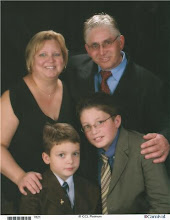ALL OF THE FOLLOWING INFORMATION IS FROM "BIRDS OF NORTH AMERICA"
Common Name: Blackburnian Warbler
Scientific Name: Dendroica fusca
Order: Passeriformes
Family: Parulidae
Juvenile Perched: N/A
Juvenile Flight: N/A
Imature Perched: N/A
Imature Flight: N/A
Adult Female Nonbreeding Perched: more subdued facial pattern, orange throat and breast, white wing bars, black streaks on flanks
Adult Female Nonbreeding Flight: N/A
Adult Female Breeding Perched: more subdued facial pattern, orange throat and breast, white wing bars, black streaks on flanks
Adult Female Breeding Flight: N/A
Adult Male Nonbreeding Perched: pale orange line center of crown, complex black and-orange face pattern, white streaks on black back, white patch on wing, brilliant orange throat, black streaks on breast and belly, white belly
Adult Male Nonbreeding Flight: white edges to outer tail feathers, bold white wing patches
Adult Male Breeding Perched: pale orange line in center of crown, complex black-and-orange face pattern, white streaks on black back, brilliant orange throat, black streaks on breast and belly, white belly
Adult Male Breeding Flight: white edges to outer tail feathers, bold white wing patches
Voice: Call a slightly husky chik; flight-call a high, thin zzee; song variable, but always high-pitched; swirling series of lisps, spiraling upward to end in an almost inaudible trill.
Nesting: Fine cup in conifer on horizontal branch away from trunk, usually high in tree; 4-5 eggs; 1 brood; May-July.
Feeding: Gleans arthropods, such as spiders, worms, and beetles; also friut.
Occurrence: Breeds in coniferous and mixed forests from Alberta east through the North Great Lakes to Newfoundland and south into the Appalachians of Georgia; migrants found in wooded, shrubby, or forest edge habitats. Winters in wet forests in Costa Rica and Panama, and southward as far as Peru.
Length: 13cm
Wingspan: 21cm
Weight: 9-12g
Social: Winter flocks
Lifespan: Up to 8 years
Status: Secure
Flight: fast, slightly undulating, and direct with rapid wing beats.
Other: This fiery beacon of the treetops is considered one of the most beautiful mambers of its family; its orange throat is unique among the North American warblers. The Blackburnian Warbler co-exists with many other Dendroica warblers in the coniferous and mixed woods of the north and east, but is able to do so by exploiting a slightly different niche for foraging-in this case the treetops. It also seeks the highest trees for nesting
Distinguishing Features: The female is like a dull adult male, but with two wing bars and no black on the face.
Avian Firefly: This male in breeding plumage glows when seen against a dark forest background.
ALL OF THE ABOVE INFORMATION IS FROM "BIRDS OF NORTH AMERICA"
For more information about the Blackburian Warbler go to birds.cornell.edu/AllAboutBirds/Blackburnian_Warbler.html/
Common Name: Blackburnian Warbler
Scientific Name: Dendroica fusca
Order: Passeriformes
Family: Parulidae
Juvenile Perched: N/A
Juvenile Flight: N/A
Imature Perched: N/A
Imature Flight: N/A
Adult Female Nonbreeding Perched: more subdued facial pattern, orange throat and breast, white wing bars, black streaks on flanks
Adult Female Nonbreeding Flight: N/A
Adult Female Breeding Perched: more subdued facial pattern, orange throat and breast, white wing bars, black streaks on flanks
Adult Female Breeding Flight: N/A
Adult Male Nonbreeding Perched: pale orange line center of crown, complex black and-orange face pattern, white streaks on black back, white patch on wing, brilliant orange throat, black streaks on breast and belly, white belly
Adult Male Nonbreeding Flight: white edges to outer tail feathers, bold white wing patches
Adult Male Breeding Perched: pale orange line in center of crown, complex black-and-orange face pattern, white streaks on black back, brilliant orange throat, black streaks on breast and belly, white belly
Adult Male Breeding Flight: white edges to outer tail feathers, bold white wing patches
Voice: Call a slightly husky chik; flight-call a high, thin zzee; song variable, but always high-pitched; swirling series of lisps, spiraling upward to end in an almost inaudible trill.
Nesting: Fine cup in conifer on horizontal branch away from trunk, usually high in tree; 4-5 eggs; 1 brood; May-July.
Feeding: Gleans arthropods, such as spiders, worms, and beetles; also friut.
Occurrence: Breeds in coniferous and mixed forests from Alberta east through the North Great Lakes to Newfoundland and south into the Appalachians of Georgia; migrants found in wooded, shrubby, or forest edge habitats. Winters in wet forests in Costa Rica and Panama, and southward as far as Peru.
Length: 13cm
Wingspan: 21cm
Weight: 9-12g
Social: Winter flocks
Lifespan: Up to 8 years
Status: Secure
Flight: fast, slightly undulating, and direct with rapid wing beats.
Other: This fiery beacon of the treetops is considered one of the most beautiful mambers of its family; its orange throat is unique among the North American warblers. The Blackburnian Warbler co-exists with many other Dendroica warblers in the coniferous and mixed woods of the north and east, but is able to do so by exploiting a slightly different niche for foraging-in this case the treetops. It also seeks the highest trees for nesting
Distinguishing Features: The female is like a dull adult male, but with two wing bars and no black on the face.
Avian Firefly: This male in breeding plumage glows when seen against a dark forest background.
ALL OF THE ABOVE INFORMATION IS FROM "BIRDS OF NORTH AMERICA"
For more information about the Blackburian Warbler go to birds.cornell.edu/AllAboutBirds/Blackburnian_Warbler.html/













2 comments:
Interesting post. I hope to see one of these this year. I have never seen one before.
Hello,
Ruth-I would like if you came to Oshawa on a Saturday so I could show you where I heard it.
Goodbye,
Birdman
Post a Comment